
Home-building design and manufacturing company Masco Corporation (NYSE: MAS) fell short of the market’s revenue expectations in Q1 CY2025, with sales falling 6.5% year on year to $1.80 billion. Its non-GAAP profit of $0.87 per share was 4.8% below analysts’ consensus estimates.
Is now the time to buy Masco? Find out by accessing our full research report, it’s free.
Masco (MAS) Q1 CY2025 Highlights:
- Revenue: $1.80 billion vs analyst estimates of $1.84 billion (6.5% year-on-year decline, 2% miss)
- Adjusted EPS: $0.87 vs analyst expectations of $0.91 (4.8% miss)
- Adjusted EBITDA: $245 million vs analyst estimates of $340.6 million (13.6% margin, 28.1% miss)
- Operating Margin: 15.9%, in line with the same quarter last year
- Free Cash Flow was -$190 million compared to -$125 million in the same quarter last year
- Organic Revenue fell 3% year on year, in line with the same quarter last year
- Market Capitalization: $13 billion
“During the first quarter, we delivered solid adjusted operating profit margin of 16.0 percent and adjusted earnings per share of $0.87, and we returned $196 million to shareholders through dividends and share repurchases,” said Masco President and CEO, Keith Allman.
Company Overview
Headquartered just outside of Detroit, MI, Masco (NYSE: MAS) designs and manufactures home-building products such as glass shower doors, decorative lighting, bathtubs, and faucets.
Home Construction Materials
Traditionally, home construction materials companies have built economic moats with expertise in specialized areas, brand recognition, and strong relationships with contractors. More recently, advances to address labor availability and job site productivity have spurred innovation that is driving incremental demand. However, these companies are at the whim of residential construction volumes, which tend to be cyclical and can be impacted heavily by economic factors such as interest rates. Additionally, the costs of raw materials can be driven by a myriad of worldwide factors and greatly influence the profitability of home construction materials companies.
Sales Growth
A company’s long-term sales performance is one signal of its overall quality. Any business can have short-term success, but a top-tier one grows for years. Over the last five years, Masco grew its sales at a sluggish 2.6% compounded annual growth rate. This was below our standards and is a poor baseline for our analysis.
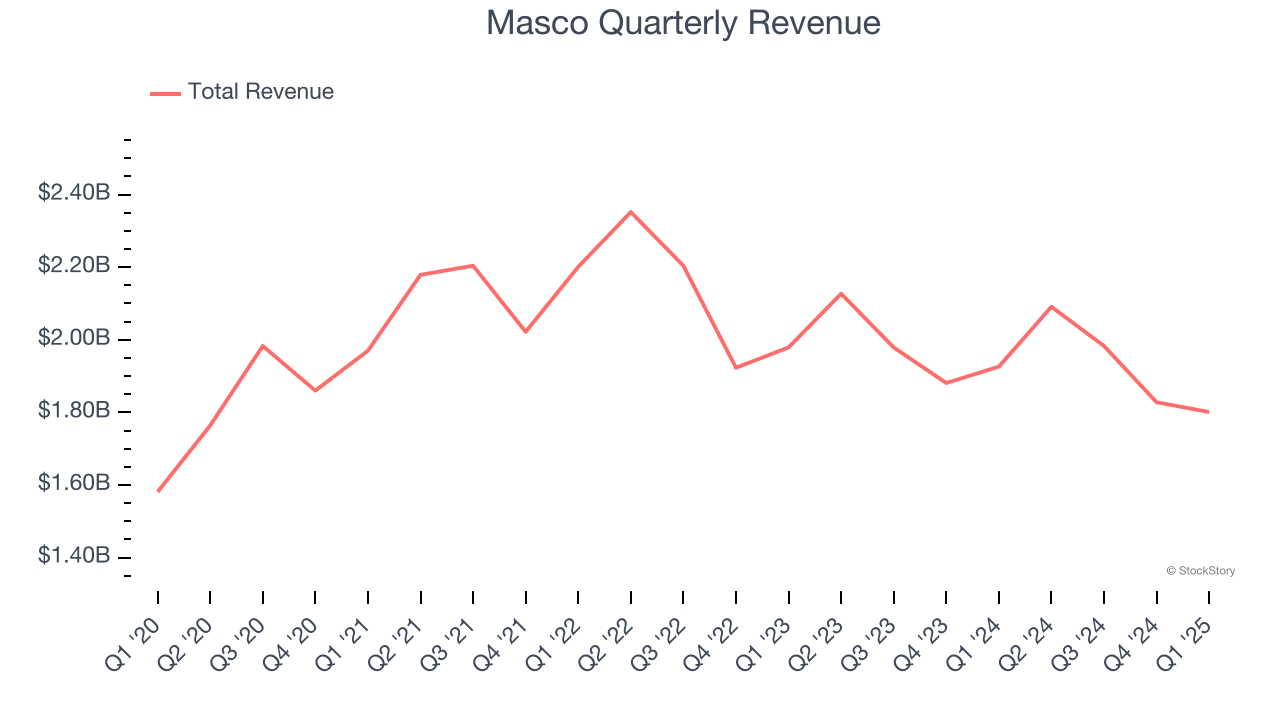
Long-term growth is the most important, but within industrials, a half-decade historical view may miss new industry trends or demand cycles. Masco’s performance shows it grew in the past but relinquished its gains over the last two years, as its revenue fell by 4.6% annually. 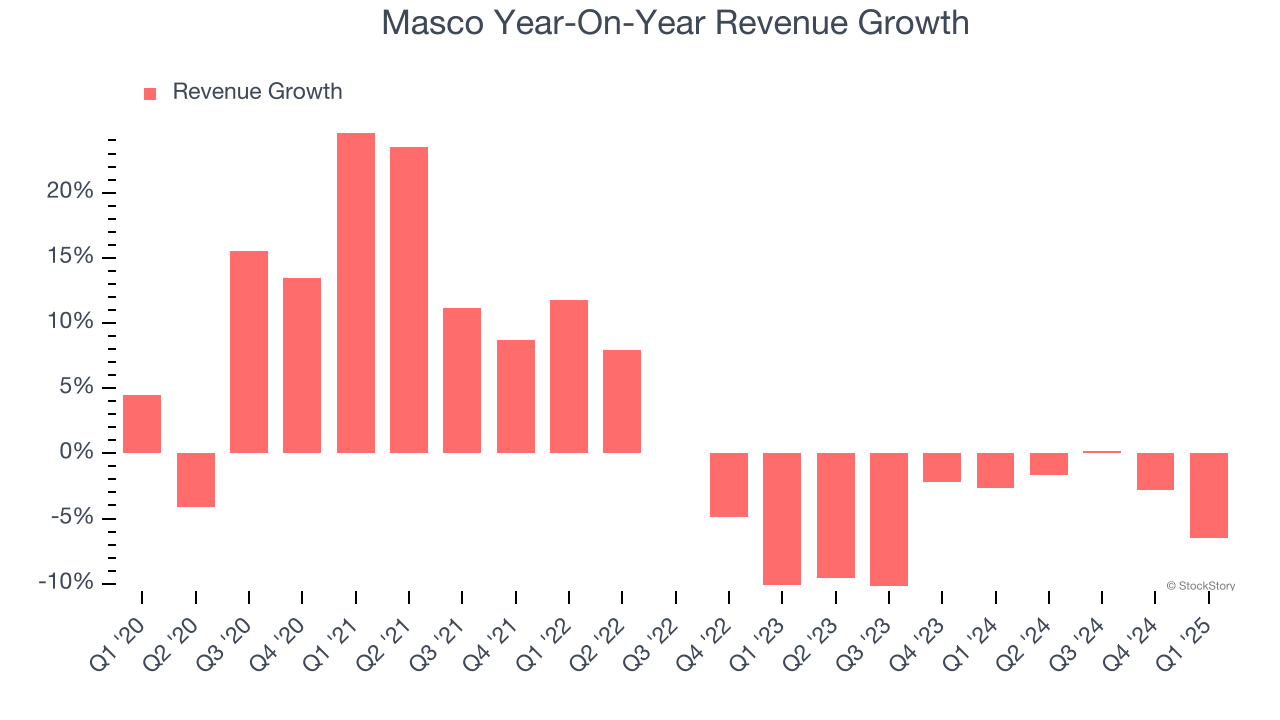
We can better understand the company’s sales dynamics by analyzing its organic revenue, which strips out one-time events like acquisitions and currency fluctuations that don’t accurately reflect its fundamentals. Over the last two years, Masco’s organic revenue averaged 4% year-on-year declines. Because this number aligns with its normal revenue growth, we can see the company’s core operations (not acquisitions and divestitures) drove most of its results. 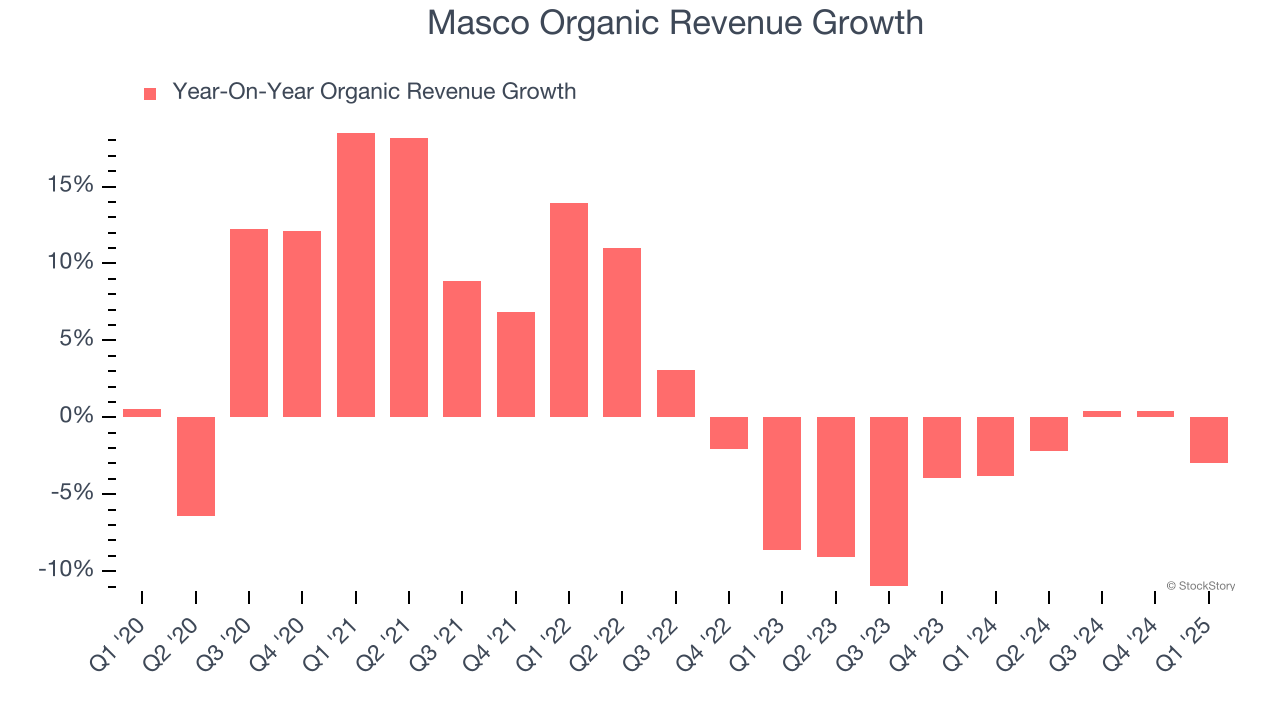
This quarter, Masco missed Wall Street’s estimates and reported a rather uninspiring 6.5% year-on-year revenue decline, generating $1.80 billion of revenue.
Looking ahead, sell-side analysts expect revenue to remain flat over the next 12 months. Although this projection implies its newer products and services will spur better top-line performance, it is still below the sector average.
Today’s young investors won’t have read the timeless lessons in Gorilla Game: Picking Winners In High Technology because it was written more than 20 years ago when Microsoft and Apple were first establishing their supremacy. But if we apply the same principles, then enterprise software stocks leveraging their own generative AI capabilities may well be the Gorillas of the future. So, in that spirit, we are excited to present our Special Free Report on a profitable, fast-growing enterprise software stock that is already riding the automation wave and looking to catch the generative AI next.
Operating Margin
Masco has been a well-oiled machine over the last five years. It demonstrated elite profitability for an industrials business, boasting an average operating margin of 16.8%. This result isn’t too surprising as its gross margin gives it a favorable starting point.
Analyzing the trend in its profitability, Masco’s operating margin decreased by 1.7 percentage points over the last five years. This raises questions about the company’s expense base because its revenue growth should have given it leverage on its fixed costs, resulting in better economies of scale and profitability.
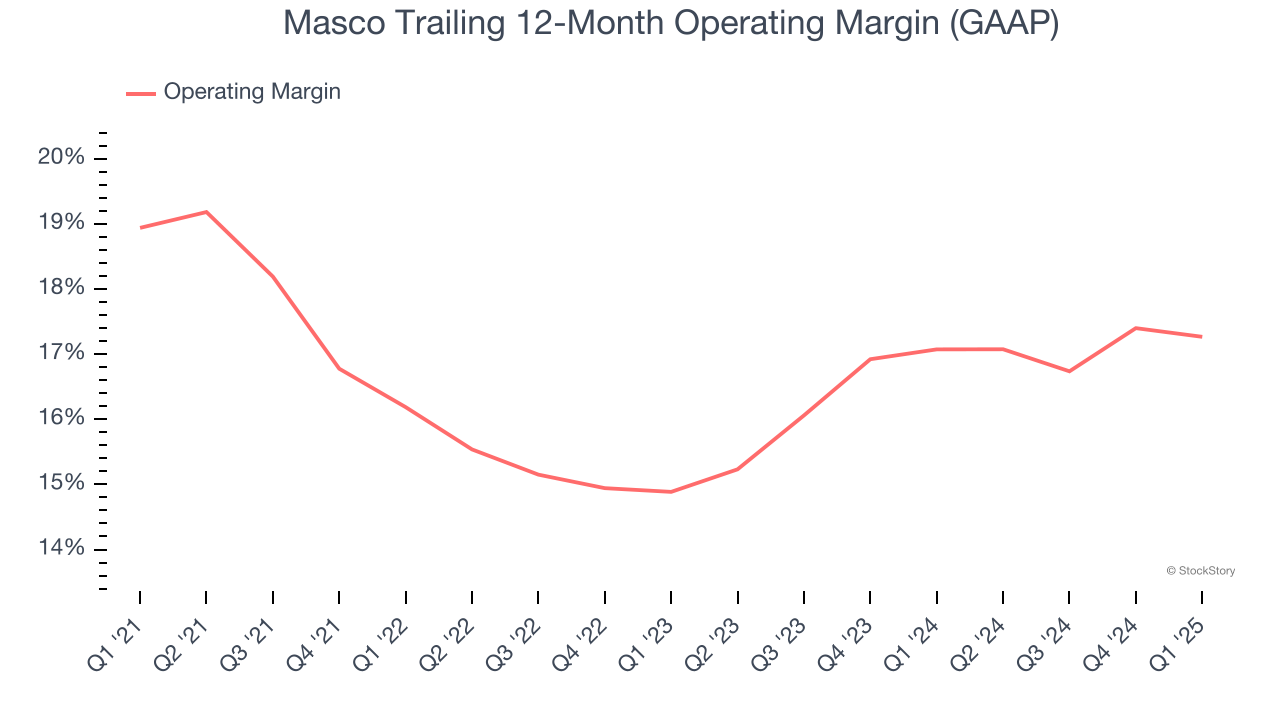
In Q1, Masco generated an operating profit margin of 15.9%, in line with the same quarter last year. This indicates the company’s cost structure has recently been stable.
Earnings Per Share
Revenue trends explain a company’s historical growth, but the long-term change in earnings per share (EPS) points to the profitability of that growth – for example, a company could inflate its sales through excessive spending on advertising and promotions.
Sadly for Masco, its EPS declined by 3.1% annually over the last five years while its revenue grew by 2.6%. This tells us the company became less profitable on a per-share basis as it expanded due to non-fundamental factors such as interest expenses and taxes.
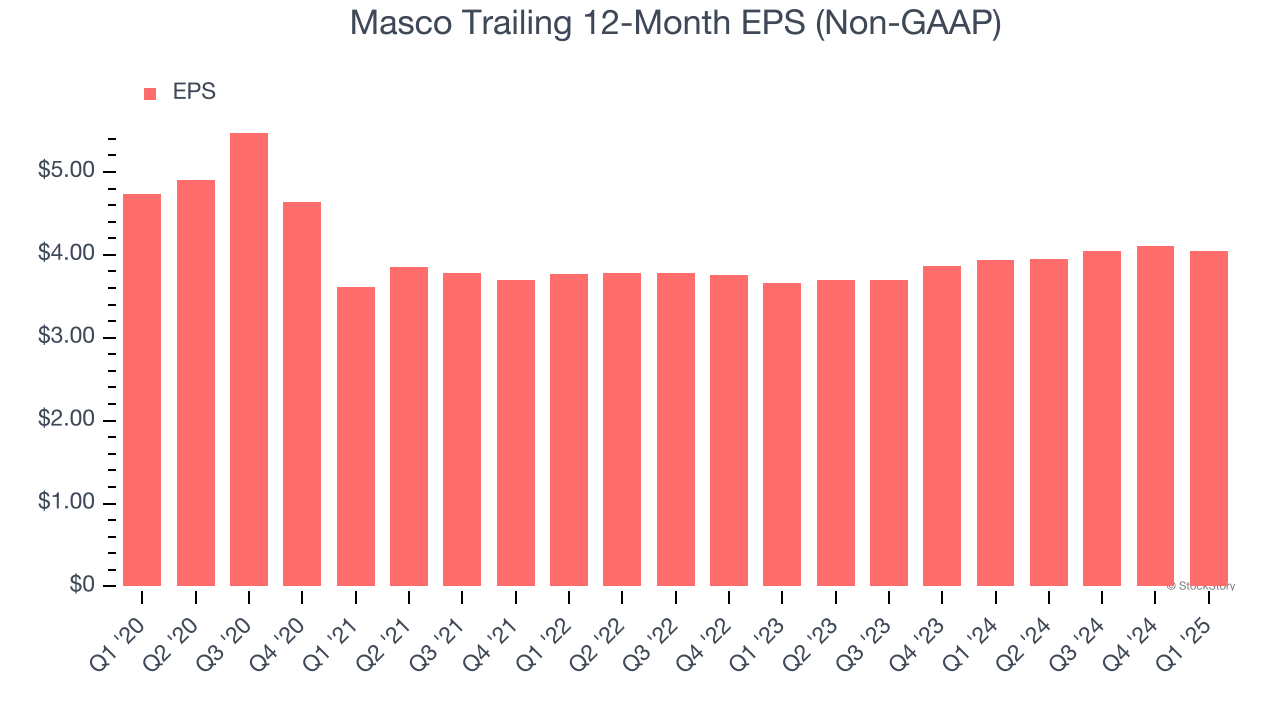
Diving into the nuances of Masco’s earnings can give us a better understanding of its performance. As we mentioned earlier, Masco’s operating margin was flat this quarter but declined by 1.7 percentage points over the last five years. This was the most relevant factor (aside from the revenue impact) behind its lower earnings; taxes and interest expenses can also affect EPS but don’t tell us as much about a company’s fundamentals.
Like with revenue, we analyze EPS over a shorter period to see if we are missing a change in the business.
Although it wasn’t great, Masco’s two-year annual EPS growth of 5.1% topped its two-year revenue performance.
In Q1, Masco reported EPS at $0.87, down from $0.93 in the same quarter last year. This print missed analysts’ estimates. Over the next 12 months, Wall Street expects Masco’s full-year EPS of $4.04 to grow 7.5%.
Key Takeaways from Masco’s Q1 Results
We struggled to find many positives in these results. Its revenue missed significantly and its EBITDA fell short of Wall Street’s estimates. Overall, this was a weaker quarter. It seems expectations were low, though, and the stock traded up 1.1% to $61.99 immediately following the results.
So should you invest in Masco right now? If you’re making that decision, you should consider the bigger picture of valuation, business qualities, as well as the latest earnings. We cover that in our actionable full research report which you can read here, it’s free.







